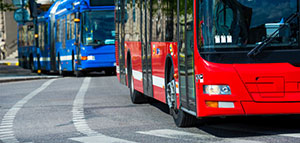

Over the past decade, network cameras have become an essential part of transportation safety and security. Thanks to the technologies that can now be integrated, the range of solutions they can be a part of has also increased: from boosting security inside vehicles to enhancing safety in passenger boarding and alighting, from improving driver behaviour to reducing track maintenance costs.
One of the key considerations when developing on-board cameras is the lifespan of the vehicles they are being built for. Train carriages are often used for up to 40 years, whereas cameras should be replaced every 7-8 years. It is important, therefore, that the cameras can easily be replaced. To achieve this, manufacturers can ensure that newer cameras have the same form and fit, so that even as technology evolves it is possible to seamlessly retrofit older train carriage interiors.
On-board cameras had a wide range of challenges to overcome before their utility could be compared to that of their static counterparts, and as such have incorporated some cutting-edge technology. Over the years, the robustness and reliability of their mechanical components have been improved, as have their imaging capabilities. New features have been added that combat challenging light conditions, restricted on-board storage and their ability to transmit data, not to mention additional features demanded by those looking to improve customer experience.
The challenges of light (and dark)
Clearly, moving vehicles are in a constantly changing environment: from bright sunlight to a pitch-dark tunnel or poor weather. When a bus or a train comes out of a dark tunnel into bright sunshine, for example, there needs to be minimal delay in adjusting to the light changes while ensuring all the forensic details are clearly visible even in the dark parts of a scene – without over-exposing the bright parts. In order to specifically address these challenging scenes, on-board cameras need to be designed with advanced image processing technologies such as Wide Dynamic Range (WDR).
Another challenge specific to transportation is that long-distance transport companies, whether they operate buses or trains, will very often turn off the lights during overnight trips to make it easier for passengers to sleep. On-board cameras must therefore be able to see more than the eye can see; even in the dark. Today, advanced image processing technologies such as Lightfinder make it possible to depict and detect objects of interest using lifelike colours even in very low light conditions. And for visibility in complete darkness, the integration of IR illumination into on-board cameras opens up new and enhanced use cases for passenger and driver safety and security.
Capture more details with less storage space
A significant drawback to legacy analogue systems is their inability to compress video. When combined with a lack of available on-board storage, this leads to footage being quickly deleted in order to create space for the new images, limiting the usefulness of the cameras. In order to address this issue, manufacturers looked at new ways of compressing the images, delivering a significant reduction in storage space and bandwidth without affecting the overall quality of the video.
As the processing power of on-board cameras has improved, so has the opportunity for advanced analytics. On-board network cameras can now also integrate with analytics applications, allowing transportation companies to access valuable data about passenger numbers and use of public transport, optimising services and staffing. Cameras can also be equipped with software that recognises left luggage, giving police and other security services extra help in detecting suspicious packages and responding more quickly.
Safety for passengers and drivers
Cameras with integrated accelerometers can record every time sudden movement is sensed, such as hard braking. This could help determine whether the braking is due to bad driving or due to traffic congestion on the route. It also makes it much easier, in post-accident investigation, to identify the video of interest within the recorded timeline. Similarly, an on-board camera with connected audio could begin to record when the horn is sounded or even when raised voices are detected, helping to ensure that there is both video footage and audio recordings of an incident.
On-board cameras have become essential for safety and security in transport. Newer and more powerful cameras are quicker to adapt to rapid light changes and capture even more details at a fraction of the storage space than they once could. Combined with smart analytics, new applications can further enhance safety and security, and improve operational efficiency and customer service.
| Tel: | +27 11 548 6780 |
| Email: | [email protected] |
| www: | www.axis.com |
| Articles: | More information and articles about Axis Communications SA |

© Technews Publishing (Pty) Ltd. | All Rights Reserved.